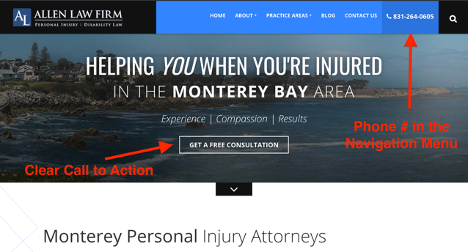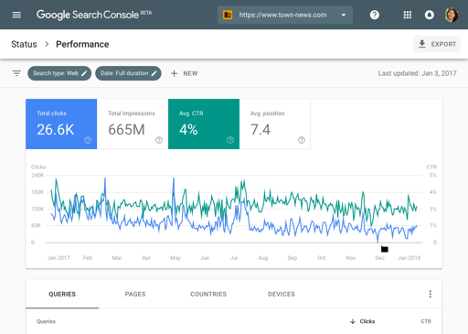This article was written by Nancy Rapp, Esq., the SEO Content Manager at PaperStreet Web Design. PaperStreet is a full service web design and marketing firm offering SEO, PPC, social media, branding services and more.
Have you ever wondered why some legal websites are more successful at turning visitors into leads while other sites go ignored? The problem is many law firms and attorneys treat their websites as online brochures rather than lead-generation tools.
Why treating your website as a brochure doesn’t work
Imagine this scenario.
A woman is going through a divorce and is searching online for legal help. One law firm website looks promising, so she clicks it and finds a long, scrolling homepage filled with text and photos highlighting the firm’s divorce attorneys, their history in the local community, and their legal accolades.
She’s happy with what she found but decides to continue her research. She happens across another law firm. Their website features a short homepage that immediately states they work specifically with divorce cases and quickly offers a free, same-day phone consultation with an empathetic attorney.
Both websites offer the same service, but which one is more likely to generate a lead? The second website follows a simple, proven, lead-generation format:
- It quickly provides value (in this case, a free phone consultation).
- It offers a clear step forward with a compelling call to action.
- It collects the lead’s information so she could be followed up with.
- It provides unique, compelling, and engaging content that answers specific needs and questions.
When viewed this way, a brochure-style website acts more like a wall that visitors have to climb over to solve their problems. On the other hand, a lead-generating website serves more like a door a visitor has to walk through.
It greets you at the door with content that addresses your need, welcomes you in, and treats you to nourishing content that builds a relationship.
Choosing the latter makes it easier for your firm to generate online leads.So how can you transform your website from a brochure to a lead gen engine? Here are seven tactics you can implement today.
Tip 1: Use strong calls to action throughout your website
A call to action (CTA) is a clickable link or button that tells your website viewer what to do next. We see CTAs online all the time: Buy Now, Sign Up Today, Schedule Your Appointment, etc. While people might say they don’t like being told what to do, data shows that having clear CTAs on your website and other marketing material dramatically increases conversions
“If your homepage’s design is what catches a person’s attention, the CTA is what keeps it.” — HubSpot
A CTA needs to be front and center on your website, and it needs to show that there’s a solution on the other side of the action taken.
Allen Law Firm provides an excellent example of a compelling CTA that maximizes lead generation for its attorneys. Instead of being greeted by walls of text and images, the visitor sees a law firm ready to help and is invited to Get a Free Consultation. Not only that, but an interactive phone number is displayed on the navigation menu, allowing them to contact the firm regardless of where they are on the website.
Source: Allen Law Firm website
When you offer value and inspire your visitors to take action, they’ll be more likely to become a lead you can follow up with.
Tip 2: Create focused landing pages for each service you offer
All law firm websites need to explain their services. That’s a given. In truth, many attorneys often overlook just how important those explanations are. For example, a person may think they need a divorce attorney, but if you don’t outline exactly how your law firm can help, perhaps the potential client will try to tackle their proceedings on their own.
If you or your law firm practice different types of law, it’s important that each service you offer has its own dedicated landing page. Separate landing pages not only give you more space to position yourself as a specialist in those fields but also provide a wide variety of other benefits, such as:
- search engine optimization
- targeted marketing for your social media and PPC campaigns
- and the ability to use intentional language and CTAs catered to visitors with different needs
For example, let’s say that your law firm specializes in both personal injury and criminal law. Rather than highlighting both services on a single page, create one page for each: a personal injury law page and a criminal law page.
Now, you can hyperfocus your messaging and CTAs on each page, speaking to each audience’s needs and pain points. Additionally, suppose you want to use PPC or social media advertising for your services. In that case, you can create two distinct sets of advertisements targeting visitors looking for a personal injury attorney or a criminal defense attorney.
When creating separate landing pages, keep in mind the visitors who will be seeing these pages. What single problem are they looking to solve, and how does this particular page help them solve it? Use unique forms and CTAs that speak directly to distinct audiences to maximize your lead and conversion rates.
Additionally, don’t be afraid to use landing pages as a place to answer difficult questions your legal leads might have. Landing pages provide an excellent way to answer questions specific to the field of law you practice. Answering these questions will provide clarity for your visitors, give them a better sense of you or your firm’s personality, and build your credibility as the solution to their problem.
For even more insightful information on how users interact with your landing pages, consider setting up unique phone numbers and form tracking to see your lead and conversion rates for each page.
Tip 3: Add detailed contact forms to your landing pages
Contact forms are the most popular and successful way to capture lead information online for your law firm. The information they provide allows you to qualify leads and follow up accordingly, which is why your contact forms must gather as much detailed information as possible.
To use forms effectively, follow these contact form best practices:
- Use four to five form fields. Studies show that fewer form fields usually result in higher conversion rates. Don’t go overboard asking potential leads for information. Only gather what you need to follow up with them efficiently.
- Place your forms on high-traffic pages. Invisible forms don’t get filled out. Place your forms on web pages that receive the most traffic, and avoid burying them at the very bottom of the page.
- Use thank-you pages. After a visitor has completed a form, consider sending them to a separate “Thank You” page to provide a personalized thank-you message and let them know what they can expect next.
Bonus: Learn how form tracking can help you increase your conversion rates
Tip 4: Incorporate FAQs into your content
Many lawyers shy away from answering legal questions on their websites. Not only do they not want to provide “legal advice,” but the concern is that by answering these questions, the potential client will decide not to pursue a lawyer. Is that a possibility? Of course. Should the law firm avoid FAQs? Absolutely not.
FAQs are of particular importance for SEO purposes for several reasons:
- Voice search is often done in question form
- Questions are often part of long-tail keyword phrases that potential clients use to search
- Questions are often highlighted as the featured snippet that displays on the search engine results page.
There are plenty of ways to research the questions that should be showcased. The “People Also Ask” function of Google and AnswerthePublic.com are great starting points.
Tip 5: Create thought leadership content that establishes your expertise
Law firm content strategies are not easy to create. Reliance on the “same old, same old” is all too common, and it’s hard to differentiate one law firm’s website from another when content is concerned. For example, pick a city and you’re likely to see at least 5 law firms outlining “What to Do After a Car Accident.” How can a prospective client pick which law firm is right for them when every practice is saying the same thing?
This is where developing thought leadership content can help. There are plenty of great topics for blogs, but one of the most valuable pieces of content are those that give your attorneys a voice.
Was a new law passed in your state? Offer your thoughts on it. Is there a controversial case in the news? Discuss it. Have some ideas for community reform? Share them.
Providing legal insight on interesting topics will help potential clients garner your personality and imagine what it will be like to work with you. It also allows you to demonstrate your legal prowess in a conversational tone.
Just be sure not to rely on legalese or otherwise wordy material that would result in prospective clients exiting your website.
Tip 6: Check your website for search engine optimization issues
Your website might look great on the outside, but if it’s not optimized for search engines, it will be tough for visitors to find your law firm. What’s worse, major SEO issues can actually hurt your website rankings, decreasing your website’s traffic.
The easiest way to check your website for SEO-related issues is to connect it to Google Search Console. Not only will it identify issues on your site, but it will provide fresh data on your overall site performance in the search rankings, including showing which keywords are driving the most traffic to your site and which pages are the most popular.
An example of the Google Search Console dashboard
Other tools you can use to fine-tune and learn more about your site’s SEO performance are Moz, Semrush, Ahrefs, SpyFu, and Ubersuggest.
In general, some of the biggest issues are broken links, page load errors, indexing issues, etc. Sometimes, a website may look perfectly fine but have some technical aspects that prevent it from ranking highly. Without using a tool, you may never notice an issue.
Tip 7: Optimize your website for mobile
Google is constantly tweaking its search engine algorithm to favor mobile-friendly websites and provide users with better experiences while surfing the Internet on their phones or tablets. As a majority of internet searches now take place on mobile devices, your website and lead-generation strategies need to meet users where they’re at.
Your ultimate goal is for your law firm website to look good and perform well on smaller screens. The first step is to use Google’s Mobile-Friendly Test to get an accurate benchmark of your site’s mobile performance. Working with Google Search Console will show you any issues you might find hindering your user’s mobile experience and guide you through how to fix them. Then, to really boost your website’s speed, make sure your site is using a secure and reliable website hosting provider and optimize your images by using image compression software.
Lead generation for attorneys is only half the battle
It’s tempting to want to pop the champagne once your newly optimized website starts turning out leads, but remember: Lead generation for law firms is only half the battle. It’s lead management — how you communicate with and nurture your leads — that will ultimately turn your new leads into new clients.
Responding quickly to inquiries, flagging highly qualified leads, tracking customer journeys with CRM software, and conducting quality-assurance checks on your lead-generating systems are only a few ways that you can help new leads become new clients.
Don’t settle for a weak website
The value of your law firm’s website for lead generation can’t be overstated. It’s essential that you take the time to make sure it’s operating effectively to attract visitors, provide immediate value, inspire them to take action, and give you a path for connection and follow-up.
The National Law Review says, “Investing in your own website is a key factor not only for lead generation but for attorney referrals, client education, etc. Over time, the value of your website is multiplied, especially when quality search engine optimization practices are followed.”
Take control of your website, optimize it for lead generation, and reap the rewards.












